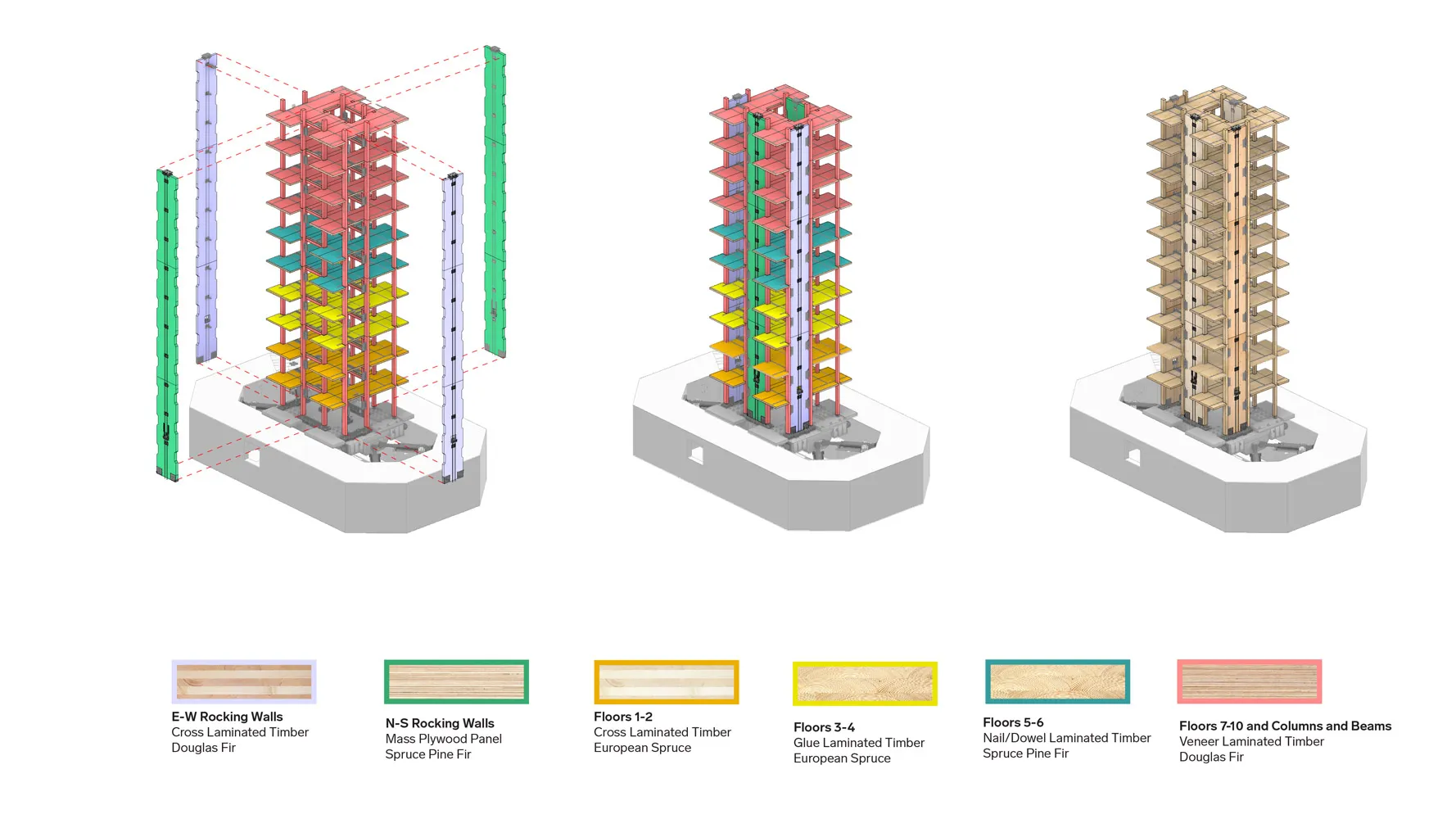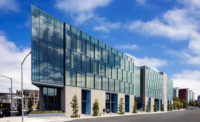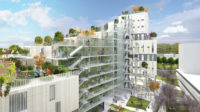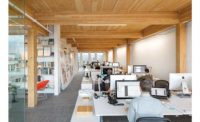On May 9, a 10-story tower was deliberately shaken with forces equal to a magnitude 6.7 earthquake, followed, minutes later, by the equivalent of a 7.7 quake. Designed by Portland, Oregon– and Los Angeles–based LEVER Architecture, in collaboration with several university and industry partners, the structure swayed and rattled under the severe stress—but then it instantly sprang back to its original vertical position, apparently unscathed. The building—which had been constructed, at a cost between $3 and $4 million, specifically to test and demonstrate the seismic resiliency of mass timber—is the centerpiece of the TallWood Project of the Natural Hazards Engineering Research Infrastructure (NHERI). After these long-anticipated simulations, each preceded by a countdown that evoked a rocket launch, participants cheered and hugged one another, celebrating the success.
The test structure, which took about nine months to build, will remain standing for nearly a year on the “shake table” at the University of California San Diego’s Englekirk Structural Engineering Center, where it was erected. This large earthquake simulator—with a 25-by-40-foot, 3-foot-thick platen, or plate, onto which the building was bolted—was upgraded in 2022, with six axes of movement, enabling it to reproduce the entire range of 3D motion possible in a seismic event. The tower incorporates different types and applications of mass timber, the multi-layered engineered-wood products whose benefits include structural strength, sustainability, and earthquake-withstanding properties. This is the tallest full-scale primarily mass-timber structure ever to undergo this type of testing.
The recent trials, which were computer-controlled and lasted just under a minute each (consistent with actual earthquake durations), simulated two major temblors from the past: California’s 1994 Northridge quake, followed by Taiwan’s even stronger 1999 Chi-Chi quake. Despite the brevity of each reenacted event, this National Science Foundation–funded project had been years in the making, involving many different entities. Led by principal investigator Shiling Pei of the Colorado School of Mines, it engaged a consortium of research institutions, including Colorado State University, Oregon State University, Lehigh University, the University of Washington, the University of Nevada, Reno, the University of California San Diego, and Pei’s own. Additionally, many industry partners contributed materials, building products, construction services, and/or expertise.
To learn as much as possible from each simulated event, the design team integrated a wide range of building conditions and components. At 112 feet tall, the tower has 32-by-34-foot floor plates, partially extending beyond the shake table, allowing the researchers to test the performance of cantilevers. Depending on the structural role and level within the building, different types of mass timber—including cross-laminated (CLT), glue-laminated (glulam), nail-laminated (NLT), dowel-laminated (DLT) and laminated-veneer lumber (LVL)—form such elements as floor slabs, walls, columns, and beams.
Though there were only resources for exterior cladding on the bottom three stories, each quadrant broadens the research scope with its own type of sheathing system and/or windows. Whereas the balloon-frame skin is independent of the floor slabs, other sheathing connects to those horizontal planes directly. The facade variations range from a glazed curtain wall system to two types of punched fenestration. “We made sure to include, for example, ribbon windows that meet at a corner,” says LEVER principal Jonathan Heppner, “because that’s often a weak spot in a quake.”
Among the many motion-accommodating measures, expansion joints separate certain materials, and some nonstructural partition walls have deflection heads with tracks to allow for seismic displacement. Similarly, the 10-story self-supporting stairway near the building’s core has flexible connections on most floors, to permit drift during seismic events.

Photo courtesy LEVER Architecture
Perhaps the tower’s most innovative feature is its mass-timber “rocking wall.” As Pei explains, “It’s a solid wood plane that rises the building’s full height and is anchored to the ground by post-tensioned steel rods (though they could be cables instead). When subjected to lateral forces, the wall rocks back and forth—which reduces seismic impact. Once the earthquake is over, the tensioned rods, or cables, pull the building right back to center, or plumb.” Although teams in both the U.S. and New Zealand had studied concrete rocking walls, the realization of a mass-timber version is a significant breakthrough. The test structure includes four of these walls—two along the building’s periphery, and two near its core—made of CLT and mass-ply panels (MPP) with integral U-shaped steel flexural plates at regular intervals, to absorb the rocking forces during an earthquake. “And if they become over-stressed,” says Heppner, “they’re replaceable afterwards—like fuses.” As with many of the tower’s structural and nonstructural parts, they’re designed to minimize earthquake damage or, following the most extreme conditions, provide for building survival with relatively easy repairs.
“The post-quake analysis here will teach us a lot,” says LEVER founding principal Thomas Robinson, “as there are more than 800 data-collecting sensors throughout the building.” As investigation continues, a simulation of an upthrusting quake followed the Northridge and Chi-Chi reenactments; eventually, the tower’s upper stories will be removed to allow researchers to study matters involving, for example, built mass relative to quake frequency.
Underscoring the test project’s value, Pei points out, “mass timber is part of a major trend in architecture and construction, but its seismic performance in tall structures is not as well understood as other existing building systems.” As several investigators mentioned during the May 9 simulation, the hope is for this project to advance the use of mass timber, particularly in earthquake-prone areas, and to lead to far-reaching building code changes for both residential and commercial structures—to include the rock and roll of seismic design: wood rocking walls.





Post a comment to this article
Report Abusive Comment